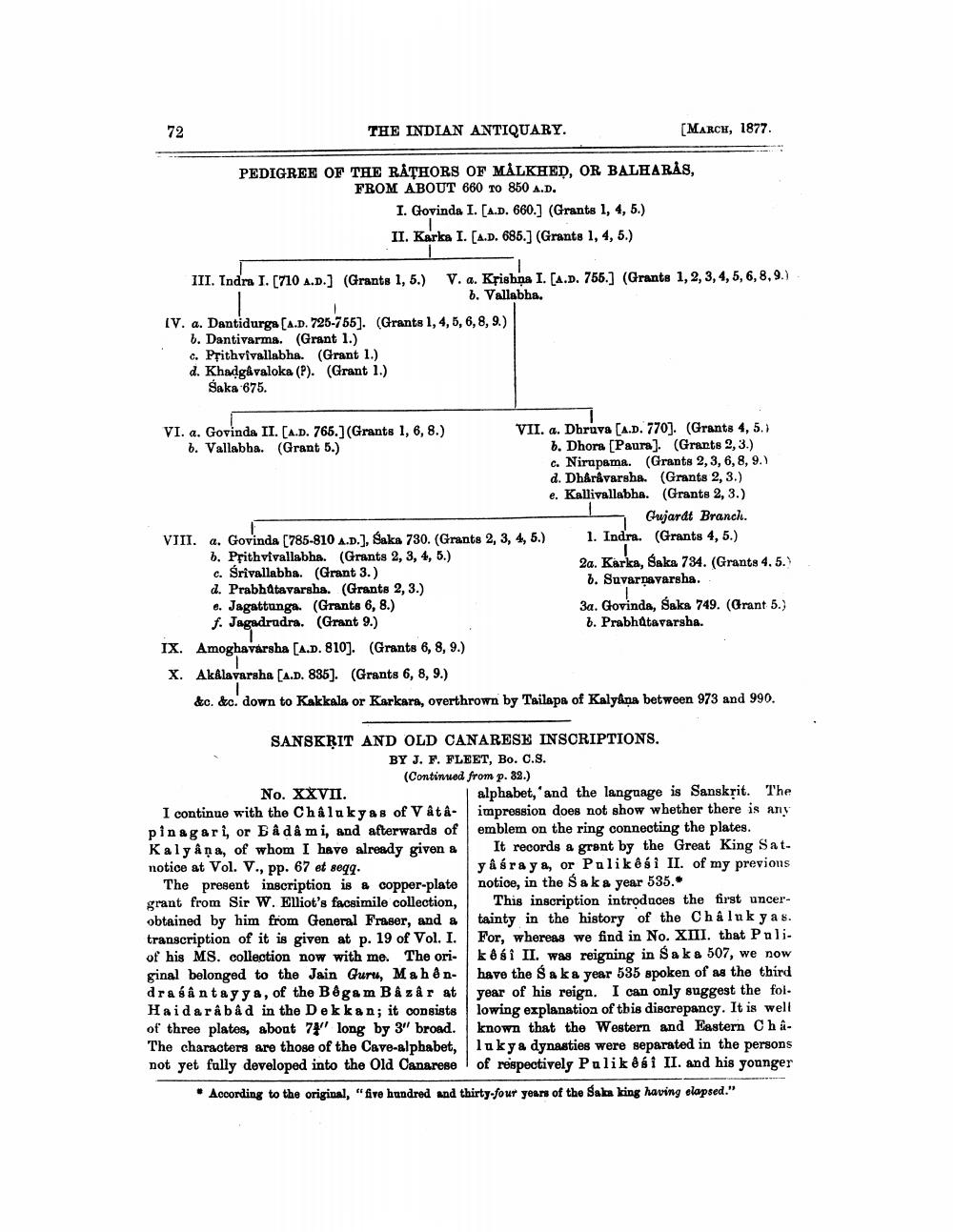________________
72
THE INDIAN ANTIQUARY.
PEDIGREE OF THE RATHORS OF MALKHED, OR BALHARÅS, FROM ABOUT 660 To 850 A.D.
I. Govinda I. [A.D. 660.] (Grants 1, 4, 5.) II. Karka I. [A.D. 685.] (Grants 1, 4, 5.)
III. Indra I. [710 A.D.] (Grants 1, 5.)
V. a. Krishna I. [A.D. 755.] (Grants 1, 2, 3, 4, 5, 6, 8, 9.)
b. Vallabha.
IV. a. Dantidurga [A.D. 725-755]. (Grants 1, 4, 5, 6, 8, 9.)
b. Dantivarma. (Grant 1.)
c. Prithvivallabha. (Grant 1.)
d. Khadgåvaloka (P). (Grant 1.) Saka 675.
VI. a. Govinda II. [A.D. 765.] (Grants 1, 6, 8.) b. Vallabha. (Grant 5.)
VIII. a. Govinda [785-810 A.D.], Saka 730. (Grants 2, 3, 4, 5.)
b. Prithvivallabha. (Grants 2, 3, 4, 5.)
c. Śrivallabha. (Grant 3.)
[MARCH, 1877.
VII. a. Dhruva [A.D. 770]. (Grants 4, 5.) b. Dhora [Paura]. (Grants 2, 3.)
c. Nirupama. (Grants 2, 3, 6, 8, 9.) d. Dhârâvarsha. (Grants 2, 3.)
e. Kallivallabha. (Grants 2, 3.) Gujarat Branch.
No. XXVII.
I continue with the Chalukyas of V âtâpinagari, or Eâdâ mi, and afterwards of Kalyana, of whom I have already given a notice at Vol. V., pp. 67 et seqq.
The present inscription is a copper-plate grant from Sir W. Elliot's facsimile collection, obtained by him from General Fraser, and a transcription of it is given at p. 19 of Vol. I. of his MS. collection now with me. The original belonged to the Jain Guru, Mahêndra sân tayya, of the Bêgam Bâzâr at Haidarâbâd in the Dekkan; it consists of three plates, about 74" long by 3" broad. The characters are those of the Cave-alphabet, not yet fully developed into the Old Canarese
1. Indra. (Grants 4, 5.)
T
2a. Karka, Śaka 734. (Grants 4. 5.) 6. Suvarnavarsha.
d. Prabhatavarsha. (Grants 2, 3.)
e. Jagattunga. (Grants 6, 8.)
f. Jagadradra. (Grant 9.)
IX. Amoghavarsha [A.D. 810]. (Grants 6, 8, 9.)
X. Akalavarsha [A.D. 835]. (Grants 6, 8, 9.)
1
&c. &c. down to Kakkala or Karkara, overthrown by Tailapa of Kalyana between 973 and 990.
SANSKRIT AND OLD CANARESE INSCRIPTIONS.
BY J. F. FLEET, Bo. C.S. (Continued from p. 32.)
3a. Govinda, Saka 749. (Grant 5.) b. Prabhatavarsha.
alphabet, and the language is Sanskrit. The impression does not show whether there is any emblem on the ring connecting the plates.
It records a grant by the Great King Satyasraya, or Pulikêsi II. of my previous notice, in the Sak a year 535.*
This inscription introduces the first uncertainty in the history of the Chalukyas. For, whereas we find in No. XIII. that Pulikêsi II. was reigning in Sak a 507, we now have the Sa ka year 535 spoken of as the third year of his reign. I can only suggest the fol lowing explanation of this discrepancy. It is well known that the Western and Eastern Châluky a dynasties were separated in the persons of respectively Palikêsi II. and his younger
According to the original, "five hundred and thirty-four years of the Saka king having elapsed."




